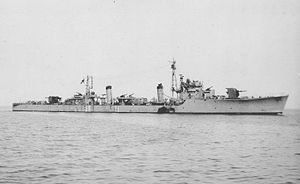Japanese destroyer Ume (1944)
 Sister ship Momi, 4 September 1944
| |
| History | |
|---|---|
| Name | Ume |
| Namesake | Japanese apricot |
| Builder | Fujinagata Shipyards, Osaka |
| Laid down | 25 January 1944 |
| Launched | 24 April 1944 |
| Completed | 28 June 1944 |
| Stricken | 10 March 1945 |
| Fate | Sunk by aircraft, 31 January 1945 |
| General characteristics (as built) | |
| Class and type | Matsu-class escort destroyer |
| Displacement | 1,282 t (1,262 long tons) (standard) |
| Length | 100 m (328 ft 1 in) ( o/a ) |
| Beam | 9.35 m (30 ft 8 in) |
| Draft | 3.3 m (10 ft 10 in) |
| Installed power |
|
| Propulsion | 2 shafts, 2 × geared steam turbines |
| Speed | 27.8 knots (51.5 km/h; 32.0 mph) |
| Range | 4,680 nmi (8,670 km; 5,390 mi) at 16 knots (30 km/h; 18 mph) |
| Complement | 210 |
| Sensors and processing systems |
|
| Armament |
|
Ume (梅, "Japanese Taiwan on the last day of the month.
Design and description
Designed for ease of production, the Matsu class was smaller, slower and more lightly armed than previous destroyers as the IJN intended them for second-line duties like escorting convoys, releasing the larger ships for missions with the fleet.kW) for a speed of 27.8 knots (51.5 km/h; 32.0 mph). The Matsus had a range of 4,680 nautical miles (8,670 km; 5,390 mi) at 16 knots (30 km/h; 18 mph).[5]
The main armament of the Matsu-class ships consisted of three
amidships for 610-millimeter (24 in) torpedoes. They could deliver their 36 depth charges via two stern rails and two throwers.[2][6]
Ume probably was not initially fitted with a
Type 13 early-warning radar. The radar and five additional 25 mm guns on single mounts were installed in late 1944.[6]
Construction and career
Authorized in the late 1942
laid down by Fujinagata Shipyards at their facility in Osaka on 1 December 1943 and launched on 24 April 1944.[8] Upon her completion on 10 June 1944, Ume was assigned to Destroyer Squadron 11 of the Combined Fleet for training and then the 43rd Destroyer Division of Destroyer Squadron 11 on 15 July. The division was transferred to the 31st Escort Squadron of the 5th Fleet on 20 August.[9]
Together with her
Sasebo to Keelung, Japanese Taiwan, then returned to Kure, between 25 October and 2 November. The division's next task was to escort the hybrid battleship/carriers Hyūga and her sister Ise as they ferried supplies to Manila, Philippines, on 9 November. American air raids deterred the battleships from completing the journey, and the ships were diverted to the Spratly Islands. She then joined the escort for the 2nd Fleet during their movement from Brunei to Mako, Japanese Taiwan.[10]
Battle of Ormoc Bay
The
run aground for the loss of three Corsairs.[11] The convoy commander then ordered his ships to beach themselves and continue to unload their troops and equipment, while the escorts withdrew northward. Further attacks that afternoon lightly damaged Ume and Sugi and sank two of the transports, while only one was able to beach itself.[10] All told, the convoy was attacked by a total of 24 Corsairs, 86 Republic P-47 Thunderbolts and 43 Curtiss P-40 Warhawks.[11] Ume arrived in Manila two days later.[10]
The ship was moderately damaged by an American bomb on 15 December, and she sailed to
822d Bombardment Squadron attacked the ships 20 miles (32 km) south of Taiwan, sinking Ume as well as damaging Kaede and Shiokaze. The latter ship rescued the survivors, but 77 men were killed and 36 wounded.[9][12]
References
Bibliography
- Futrell, Frank (1983) [1953]. Craven, Wesley F. & Cate, James L. (eds.). The Pacific: Matterhorn to Nagasaki: June 1944 to August 1945. The Army Air Forces in World War II. Vol. 5. Washington, D.C.: Office of Air Force History.
- ISBN 0-935553-26-6.
- Jentschura, Hansgeorg; Jung, Dieter & Mickel, Peter (1977). Warships of the Imperial Japanese Navy, 1869–1945. Annapolis, Maryland: United States Naval Institute. ISBN 0-87021-893-X.
- Nevitt, Allyn D. (1 January 2024). "IJN Momo: Tabular Record of Movement". www.combinedfleet.com. Retrieved 27 March 2024.
- Nevitt, Allyn D. (7 January 2012). "IJN Ume: Tabular Record of Movement". www.combinedfleet.com. Retrieved 27 March 2024.
- Stille, Mark (2013). Imperial Japanese Navy Destroyers 1919–45 (2): Asahio to Tachibana Classes. Botley, UK: Osprey Publishing. ISBN 978-1-84908-987-6.
- Sturton, Ian (1980). "Japan". In Chesneau, Roger (ed.). Conway's All the World's Fighting Ships 1922–1946. Greenwich, UK: Conway Maritime Press. ISBN 0-85177-146-7.
- ISBN 0-87021-326-1.
